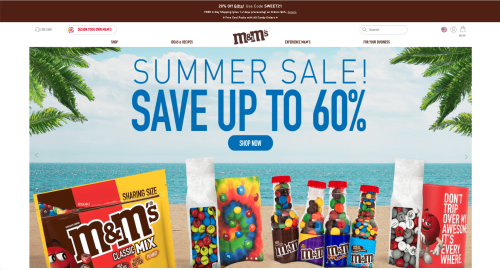Category
Tags
As CPG brands are building eCommerce websites in an evolving industry, we’re looking at the direct-to-consumer brands that started it all, and the lessons their stories can teach bigger merchants.
CPG Trends & The DTC Revolution
Throughout the course of the COVID-19 pandemic, the eCommerce space has made room for the likes of big name brands such as Heinz and M&M’s. CPG companies that have previously reigned in big-box retailers suddenly felt the push to move online in order to adapt to the new economic conditions.
According to Forrester data, nonperishable products, including CPG, grew from 38% of online grocery subcategories to 76% during the pandemic. With growing health concerns, consumers adopted new shopping habits and learned to buy more of their necessities online.
But for the brands forced to move online so rapidly, where’s the blueprint? Where are these corporations finding their inspiration and what does the strategy look like? The answer lies with the original eCommerce disruptors: the digitally native vertical brands (otherwise known as DNVBs).
In recent years, eCommerce experts have become very familiar with brands like UNTUCKit and Casper, who created massive success with the direct-to-consumer model. These DTC merchants grew so much online that they were ultimately able to take their digital businesses to brick-and-mortar stores.
Now, in the wake of a major economic upheaval, the time has come for many big companies to do the reverse of well-known DNVBs. CPGs that have previously relied on in-store purchases now need to diversify their revenue streams and adopt an omnichannel approach that includes eCommerce stores and strong online presence.
CPGs Need To Prepare For Upcoming Data Changes
With Google killing-off third-party cookies in 2022 amongst a plethora of other data privacy legislation already impacting the digital marketing world), CPGs are feeling the pressure to compensate for their historical lack of customer data ownership.
In short, not only has demand moved online, but CPG companies have strategically chosen to open up eComm shops in efforts to grab more first-party consumer data. Retailers (hey there, Amazon) who have previously owned the point-of-sale for these big brands have had primary control of this information. As the space evolves, and brands own their online POS, they are able to acquire more firsthand knowledge about their customers than when selling through another party.
Analytics may be changing, but brands who own their customer journey will still be able to know their fans on an in-depth level. As merchants develop their online presence and create high-performing digital experiences, they are able to build user trust in a way that will allow them to collect more consumer data first-hand.
What CPG Merchants Can Learn From DTCs
What makes a successful DTC brand? We’ve seen quite a few innovative examples of merchants that have started through an online shop and grown into mega-popular lifestyle brands with large loyal customer bases. With the introduction of more CPGs into the eCommerce space, these companies are seeking to create exceptional brand experiences like their predecessors.
If CPGs are to take a page out of the most successful playbooks, here are what the DNVBs and the unicorn DTCs have gotten right:
1) Carefully Curated Content
Digital marketers and eCommerce experts know the phrase well: Content is King. When it comes to establishing an online presence, curating a thoughtful content strategy is paramount. The most prominent direct-to-consumer brands have crafted memorable and impactful customer experiences through quality content.
The key to successful content initiatives– whether on your eCommerce website or in other channels– is to know your customers and always aim to foster a deeper relationship with them. Providing content that enriches the customer experience is a surefire way to boost their trust in your brand and to also keep them coming back for more.
The brands that will continue to reign supreme despite data privacy changes are the ones that have already earned the right to be in their customers’ inboxes. These are the brands that have created unique and meaningful experiences for their customers.

M&M’s DTC site is a great example of a high-performing online shopping experience because of their well-branded, quality content.
2) Brand Awareness
Carving out your brand’s own space online can be challenging in today’s competitive environment. With not only your eCommerce store to worry about, but also numerous social media platforms, there are a lot of places brands need to be at once. Crafting consistent brand messaging and a similar experience across all channels is an important part of establishing your business’s direct-to-consumer presence.
When it comes to digital marketing for CPG brand awareness, here are some key things to keep in mind:
- Keep pushing your differentiators and core messaging (through all your different channels)
- Ensure your brand is easily discoverable through keywords (SEO) and product placements on the sites of partners
- Leverage DTC site coupons to incentivize users to visit the online store and purchase through that method
- Engage directly with customers and surprise and delight them
3) Shipping & Fulfillment
The primary logistical challenge for CPG companies that are entering eCommerce is usually related to shipping and fulfillment. Because this is a new channel where it can be harder to forecast demand, it is difficult for many CPGs to keep up with online orders. This also leads to the next issue, which is thinner margins. CPG brands typically have seen significantly higher shipping and warehouse costs when selling online compared to brick-and-mortar.
One way that CPG merchants can alleviate some of these growing pains is through leveraging pre-existing relationships with brick-and-mortar retailers to help with their new eCommerce strategies. Merchants should try to collaborate closely with omnichannel retailers that can help ensure they meet demand and also reduce the fines they pay.
4) Subscriptions
Consumer Packaged Goods are usually prime offerings for a subscription model business. If you’re a merchant offering packaged products, odds are you have some kind of opportunity to create a recurring revenue stream.
With the pandemic, the popularity of subscriptions has been on the rise. Analysts predict the global subscription eCommerce market to reach $478 billion by 2025, growing at a compound annual growth rate (CAGR) of 68% from 2019-2025.
Consumers that had not previously tried out a subscription opted into them out of convenience and safety concerns in 2020. Now, as the world adjusts, most brands should be capitalizing on this opportunity that has arisen from a segment of consumers welcoming subscriptions with open arms.
Subscriptions are an excellent way to increase customer lifetime value (CLTV) and conversion. By offering subscription perks, such as a discount or free shipping, brands are able to convert and retain more customers than with one-time purchasers.

4) Creating A DTC Brand Customers Advocate For
Along with brand awareness, merchants should be prioritizing the creation of a brand that their customers love and will sing praises about.
Learn More About CPGs In eCommerce
Looking to chat through your eCommerce strategy? Our experienced strategists have helped grow some of the most revolutionary DTC brands on the Shopify Plus platform. Reach out to us here.




